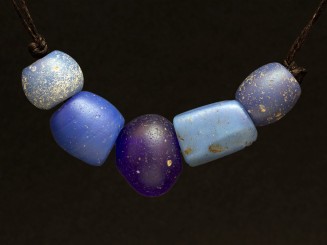5 Dutch trade beads (Blue Dutch Dogon)
Mali
Weight: 26 gr
Units: 5
Five beautiful old glass trade beads made in Europe in the eighteenth century and brought to West Africa for commercial trade. All of them probably Dutch except for the faceted, that would be of Czech manufacture (Bohemia) and popularly known as Russian Blue. These blue beads are very much to the taste of the Dogon people of Mali, where they are among the most precious, due in part to the powers attributed to this color by this culture.
The central bead is 16mm long and 20mm in diameter.
These antique wound glass trade beads are commonly known as Dutch Dogon. The reason for that is that they were first made in The Netherlands and it would become extremely popular among the Dogon people in Mali. They are quite large in size and the are usually found in bkue color though they were also made in white, black and brown. The first ones known date as back as the XVIIth century. Very attractive and eye-catching.
We use the term trade beads to refer to the European made glass beads that were used by the European merchants and explorers in the trade in Africa as from the 15th century and continued during their colonial expansion.
The history of trade beads in Africa takes us then to the 15th century and the arrival of the European, mainly the Portuguese, to the coasts of West Africa. The European discovered quite soon how much the people they met there fancied beads and saw they an opportunity for trade. Amongst the beads that captivated the African people most were glass beads since the techniques for their making had not yet been developed locally. The locals fell for the precious and colorful glass beads such as Venetian millefiori or chevron beads that the European traders had on offer and bartered them for commodities such as precious woods, ivory, gold and even used, ignominiously, in the slave trade. The increasing demand in Africa of European made glass beads continued quite until the first half of the 20th century and it had a boosting effect in the production in cities such as Venice which glass beads became very popular and coveted.



